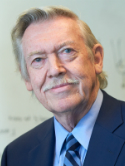Differential expression of class II MHC antigens in subpopulations of human hematopoietic progenitor cells Journal Article
| Authors: | Ottmann, O. G.; Nocka, K. H.; Moore, M. A. S.; Pelus, L. M. |
| Article Title: | Differential expression of class II MHC antigens in subpopulations of human hematopoietic progenitor cells |
| Abstract: | Expression of major histocompatibility complex class II Ags HLA-DR, HLA-DP, and HLA-DQ on human BM granulocyte-erythroid-macrophage-megakaryocyte CFU (CFU-GEMM), BFU-E, and CFU-GM was examined by indirect immunofluorescence, cell sorting, and complement-mediated cytotoxicity. BM, highly enriched for progenitor cells by depletion of mature hematopoietic elements, was further separated by sterile sorting into HLA-DR (-), low, intermediate, and high intensity HLA-DR (+), as well as HLA-DP (+) and HLA-DP (-) cell fractions and assayed for progenitor cell content. In addition, in the case of HLA-DR, CFU-GM response to inhibition by prostaglandin E was determined. Cell sorting and cytotoxicity data confirm that approximately 95% of assayable erythroid, myeloid, and multipotential progenitor cells expressed HLA-DR, whereas HLA-DQ Ags were undetectable. HLA-DR and HLA-DP Ags were co-expressed on 61% of these progenitor cells, predominantly those expressing HLA-DR at high intensity. Day 7 and 14 CFU-GM showed a trend toward segregation to the high HLA-DR (+) cell fractions, especially when recombinant human G-CSF was used to stimulate clone formation. Both day 7 and day 14 CFU-GMs were found predominantly in the HLA-DP (+) cell fraction. In contrast, BFU-E and CFU-GEMM were found in the low intensity HLA-DR cell fraction and predominantly in the HLA-DP (-) fraction. Both eosinophils CFU and cells giving rise to basophil/mast cells in suspension culture were found in the low and intermediate intensity HLA-DR fractions, but could be segregated into HLA-DP (+) and HLA DP (-) cell fractions, respectively. Functional analysis on day 7 CFU-GM segregated, based upon HLA-DR intensity, indicated a positive correlation, between increasing HLA-DR intensity and responsiveness to inhibition by prostaglandin E. Furthermore, only those CFU-GM expressing HLA-DR at high intensity could be removed by cytolytic treatment using a mAb anti-HLA-DR previously shown to be selective for CFU-GM responsive to PGE and in S phase of the cell cycle. |
| Keywords: | adult; human cell; antigen expression; cytology; bone marrow cells; bone marrow; antibodies, monoclonal; major histocompatibility antigen class 2; cell subpopulation; hematopoietic stem cells; cytotoxicity, immunologic; hematopoiesis; hematopoietic stem cell; histocompatibility antigens class ii; colony-forming units assay; cell separation; cytochemistry; antigen-presenting cells; human; priority journal; support, non-u.s. gov't; support, u.s. gov't, p.h.s. |
| Journal Title: | Leukemia |
| Volume: | 2 |
| Issue: | 10 |
| ISSN: | 0887-6924 |
| Publisher: | Nature Publishing Group |
| Date Published: | 1988-10-01 |
| Start Page: | 677 |
| End Page: | 686 |
| Language: | English |
| PUBMED: | 3172844 |
| PROVIDER: | scopus |
| DOI/URL: | |
| Notes: | Article -- Export Date: 6 August 2020 -- Source: Scopus |
Citation Impact
Related MSK Work





